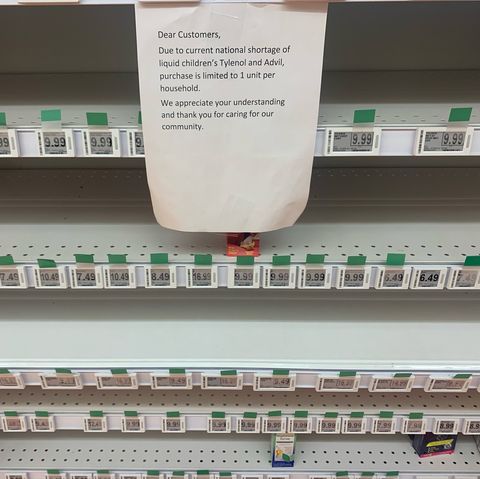- A “tridemic” of respiratory issues are currently causing a shortage of a commonly used antibiotics for children, as well as some over-the-counter cold medications.
- The shortage is expected to last for several weeks to months in some cases.
- Doctors urge parents to exercise caution in substituting other medications for these drugs on their own.
- The good news: There are ways you can safely substitute medications for your kids, by following expert tips and consulting with your child’s doctor.
Parents are racing to pharmacies all across the country, desperately seeking antibiotics and cold medicines for their children. As one mother was told, “I am not seeing any antibiotic that can treat pneumonia within 50 miles of here.”
This scary problem is due to a widespread medication shortage. The Food and Drug Administration (FDA) has specifically listed amoxicillin, an antibiotic widely prescribed for children, in short supply.
A “tridemic” of respiratory illnesses — RSV, the flu and COVID-19 — have also left store shelves cleaned out of many liquid formulas of acetaminophen, the fever and pain medication many parents give their kids. Tylenol is temporarily unavailable in some areas.
Let’s take a closer look at why the shortage is happening, how long it’s expected to last, and what you can do to find the right alternative medications for your kids.
Why is there a shortage of children’s antibiotics and cold medicine?
The main reason: Kids are simply getting sick more often. “What I’m seeing is that kids didn’t get sick as much over the past couple of years because of masking and social distancing,” says Meghan Martin, MD, a pediatric emergency medicine physician at Johns Hopkins All Children’s Hospital in St. Petersburg, FL. “Now, it’s like they’re playing catch-up — getting sick multiple times.”
For example, the Centers for Disease Control (CDC) reports that more than 2 million kids under the age of 5 get outpatient treatment for RSV every fall and winter. This year’s numbers are expected to soar much higher. We can already see it in action: In November 2021, a little more than 18,000 patients were diagnosed with RSV in the United States; in November 2022, that number is closer to 70,408. (This could also be due to a change in seasonality, with RSV hitting earlier.)
Now that COVID rules have largely been relaxed, kids are starting at square one in terms of germ exposure. “Their immune systems have been de-conditioned over the past few years of not being exposed to viruses,” says Neil Bhattacharyya, MD, FACS, a comprehensive ENT at Massachusetts Eye and Ear in Boston and a professor of otolaryngology at Harvard Medical School. The result: Your kids are not only more likely than ever to pick up viruses, but also to struggle with uncomfortable symptoms.
You might be wondering if supply chain issues are another cause of the shortage, the way they affected the availability of baby formula. Because of the COVID-19 pandemic, supply chain disruptions have definitely been a serious recent problem. According to data from Northwestern University, manufacturing plant problems can also cause medication shortages; these have to be reported to the FDA, which means production lines must shut down. While these situations can potentially cause a lack of availability, they are not thought to be having a major impact on the current medication shortage. It really comes down to heavy consumer demand.
When will the kids’ medication shortage end?
It’s hard to say for sure. According to the American Academy of Pediatrics (AAP), the amoxicillin shortage is expected to last several months. Tylenol is temporarily out of stock in some parts of the country, but its manufacturer, Johnson & Johnson, says it is ramping up production as quickly as possible.
Your best bet: Frequently check the website of any OTC product you’re searching for. The FDA’s website also posts updates on drug shortages for real-time information.
Can parents and caregivers substitute different antibiotics or OTC medicine?
Sometimes. The AAP has also advised doctors that a number of antibiotics can be substituted for amoxicillin, including penicillin. Ask your child’s doctor in detail about which medications may be appropriate to prescribe instead, to make sure your child will not be at risk for an allergic reaction.
Can’t kids just take adult medicine?
No. It’s not a safe idea, because some ingredients in adult meds can be toxic to young children.
“You also don’t want to give adult doses to your child,” Dr. Martin says. Trying to reduce a portion of an adult dose to give a child is not recommended. “Most, but not all, of the recommended doses in over-the-counter medications are based on a child’s weight in large part,” Dr. Bhattacharyya explains. “You can’t try to cut an adult medication pill to match the right dosage — it’s not going to be accurate.”
“Also, don’t crush adult medication to give to your kids,” he adds. Kids in general can learn to swallow pills between the ages of 6 and 11. Still, that is not the safest, easiest bet. If available, “an appropriate, recommended liquid dose of a children’s medication is always best,” says Dr. Martin.
You can, however, substitute a new type of acetaminophen or ibuprofen for what you normally use. Ask your child’s doctor if you can give Children’s Motrin, for example, if Children’s Tylenol is not available.
One important caveat: “Never give your child two ibuprofen medications at the same time,” Dr. Martin stresses. Other medicines, like allergy meds for example, might contain ibuprofen, and you don’t want to accidentally give too much.
In addition, “don’t sub in aspirin for Tylenol or Motrin,” Dr. Bhattacharyya says. “Aspirin can cause Reye’s syndrome, a serious condition in children.”
What else can parents and caregivers do when their children get sick?
If your child definitely needs an antibiotic and is, say, allergic to a suggested substitute, call your drugstore and ask if it’s compounding certain medications during the shortage. If not, your child’s doctor can potentially assist you in finding local pharmacies that are.
Common sense is also a great idea for preventing a second virus-go-round. “Having your child wear a mask, practice social distancing, and avoid people who are sick during the holidays — that is all awesome,” says Dr. Martin. Though the situation is scary, try not to stress. The shortage will end, and in the meantime, the easiest strategies can be the most effective when it comes to getting, and keeping, your child well.

Lisa Mulcahy is an internationally established health writer whose credits include Good Housekeeping, Prevention, Oprah Daily, Woman’s Day, Elle, Cosmopolitan, Glamour, Parade, Health, Self, Family Circle and Seventeen. She is the author of eight best-selling books, including \The Essentials of Theater.\

